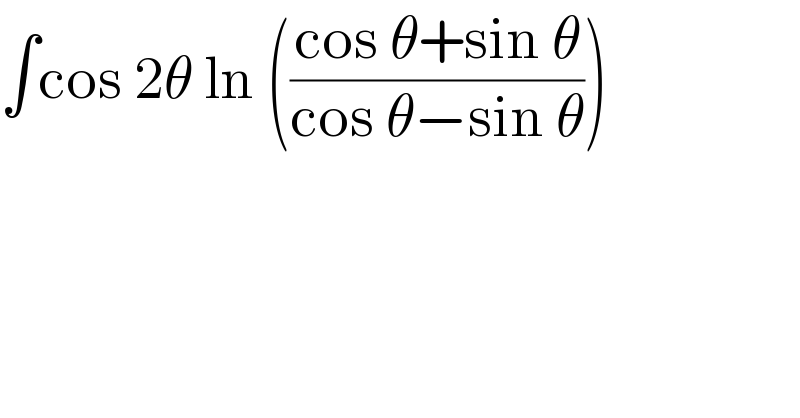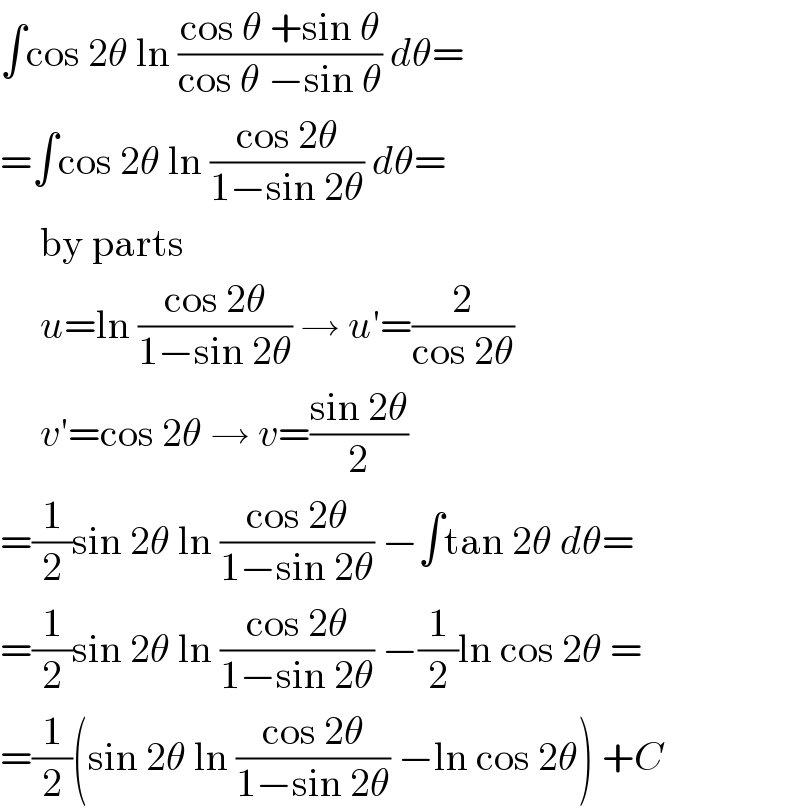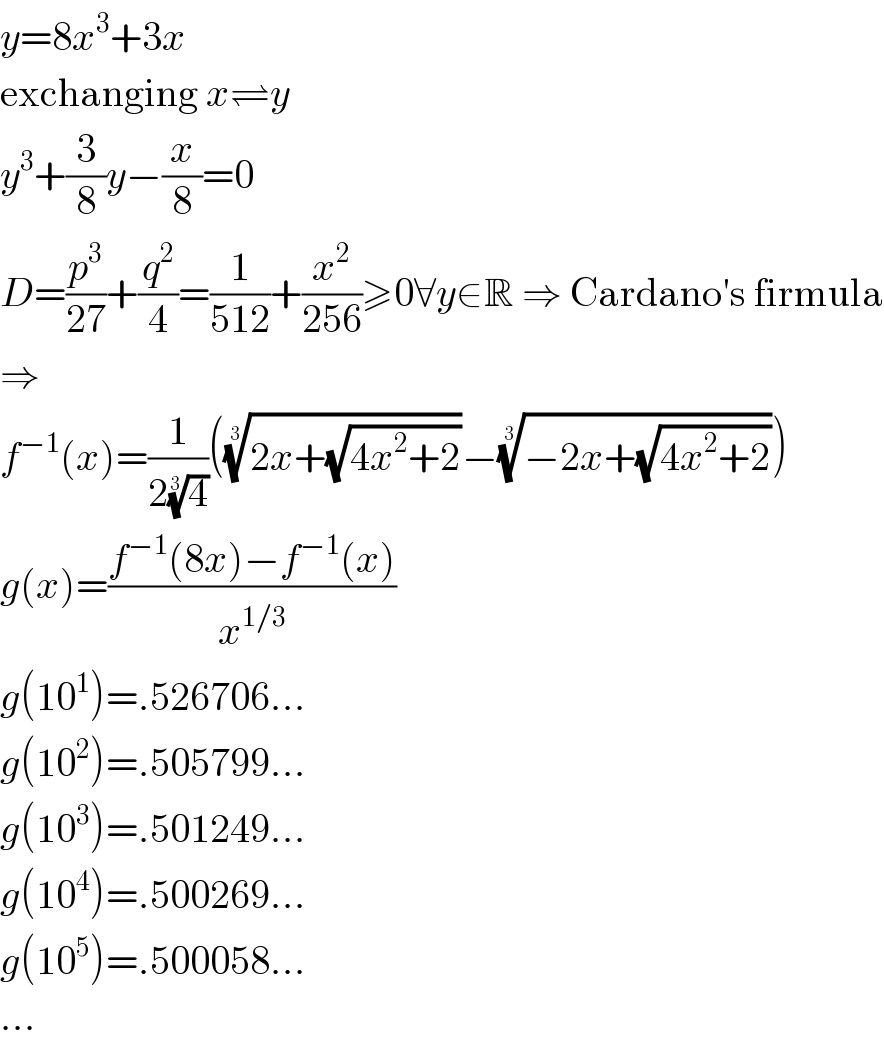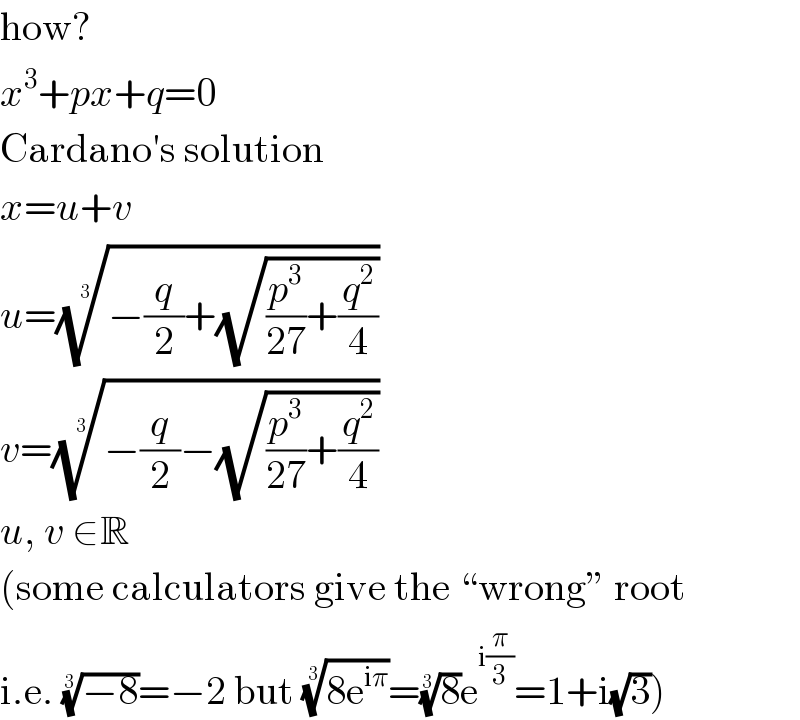Question Number 76963 by peter frank last updated on 01/Jan/20

$$\int\mathrm{cos}\:\mathrm{2}\theta\:\mathrm{ln}\:\left(\frac{\mathrm{cos}\:\theta+\mathrm{sin}\:\theta}{\mathrm{cos}\:\theta−\mathrm{sin}\:\theta}\right) \\ $$
Answered by MJS last updated on 02/Jan/20

$$\int\mathrm{cos}\:\mathrm{2}\theta\:\mathrm{ln}\:\frac{\mathrm{cos}\:\theta\:+\mathrm{sin}\:\theta}{\mathrm{cos}\:\theta\:−\mathrm{sin}\:\theta}\:{d}\theta= \\ $$$$=\int\mathrm{cos}\:\mathrm{2}\theta\:\mathrm{ln}\:\frac{\mathrm{cos}\:\mathrm{2}\theta}{\mathrm{1}−\mathrm{sin}\:\mathrm{2}\theta}\:{d}\theta= \\ $$$$\:\:\:\:\:\mathrm{by}\:\mathrm{parts} \\ $$$$\:\:\:\:\:{u}=\mathrm{ln}\:\frac{\mathrm{cos}\:\mathrm{2}\theta}{\mathrm{1}−\mathrm{sin}\:\mathrm{2}\theta}\:\rightarrow\:{u}'=\frac{\mathrm{2}}{\mathrm{cos}\:\mathrm{2}\theta} \\ $$$$\:\:\:\:\:{v}'=\mathrm{cos}\:\mathrm{2}\theta\:\rightarrow\:{v}=\frac{\mathrm{sin}\:\mathrm{2}\theta}{\mathrm{2}} \\ $$$$=\frac{\mathrm{1}}{\mathrm{2}}\mathrm{sin}\:\mathrm{2}\theta\:\mathrm{ln}\:\frac{\mathrm{cos}\:\mathrm{2}\theta}{\mathrm{1}−\mathrm{sin}\:\mathrm{2}\theta}\:−\int\mathrm{tan}\:\mathrm{2}\theta\:{d}\theta= \\ $$$$=\frac{\mathrm{1}}{\mathrm{2}}\mathrm{sin}\:\mathrm{2}\theta\:\mathrm{ln}\:\frac{\mathrm{cos}\:\mathrm{2}\theta}{\mathrm{1}−\mathrm{sin}\:\mathrm{2}\theta}\:−\frac{\mathrm{1}}{\mathrm{2}}\mathrm{ln}\:\mathrm{cos}\:\mathrm{2}\theta\:= \\ $$$$=\frac{\mathrm{1}}{\mathrm{2}}\left(\mathrm{sin}\:\mathrm{2}\theta\:\mathrm{ln}\:\frac{\mathrm{cos}\:\mathrm{2}\theta}{\mathrm{1}−\mathrm{sin}\:\mathrm{2}\theta}\:−\mathrm{ln}\:\mathrm{cos}\:\mathrm{2}\theta\right)\:+{C} \\ $$
Commented by john santu last updated on 02/Jan/20

Commented by john santu last updated on 02/Jan/20

$${to}\:{Mr}\:{MJS}\: \\ $$
Commented by peter frank last updated on 02/Jan/20

$${thank}\:{you} \\ $$
Commented by MJS last updated on 02/Jan/20

$$\mathrm{I}\:\mathrm{get}\:\underset{{x}\rightarrow\infty} {\mathrm{lim}}=\frac{\mathrm{1}}{\mathrm{2}} \\ $$$$\mathrm{by}\:\mathrm{calculating}\:{f}^{−\mathrm{1}} \left({x}\right)\:\mathrm{and}\:\mathrm{then}\:\mathrm{approximating} \\ $$
Commented by jagoll last updated on 02/Jan/20

$$\mathrm{how}\:\mathrm{sir}?\:\mathrm{please}\:\mathrm{your}\:\mathrm{write} \\ $$$$ \\ $$
Commented by MJS last updated on 02/Jan/20

$${y}=\mathrm{8}{x}^{\mathrm{3}} +\mathrm{3}{x} \\ $$$$\mathrm{exchanging}\:{x}\rightleftharpoons{y} \\ $$$${y}^{\mathrm{3}} +\frac{\mathrm{3}}{\mathrm{8}}{y}−\frac{{x}}{\mathrm{8}}=\mathrm{0} \\ $$$${D}=\frac{{p}^{\mathrm{3}} }{\mathrm{27}}+\frac{{q}^{\mathrm{2}} }{\mathrm{4}}=\frac{\mathrm{1}}{\mathrm{512}}+\frac{{x}^{\mathrm{2}} }{\mathrm{256}}\geqslant\mathrm{0}\forall{y}\in\mathbb{R}\:\Rightarrow\:\mathrm{Cardano}'\mathrm{s}\:\mathrm{firmula} \\ $$$$\Rightarrow \\ $$$${f}^{−\mathrm{1}} \left({x}\right)=\frac{\mathrm{1}}{\mathrm{2}\sqrt[{\mathrm{3}}]{\mathrm{4}}}\left(\sqrt[{\mathrm{3}}]{\mathrm{2}{x}+\sqrt{\mathrm{4}{x}^{\mathrm{2}} +\mathrm{2}}}−\sqrt[{\mathrm{3}}]{−\mathrm{2}{x}+\sqrt{\mathrm{4}{x}^{\mathrm{2}} +\mathrm{2}}}\right) \\ $$$${g}\left({x}\right)=\frac{{f}^{−\mathrm{1}} \left(\mathrm{8}{x}\right)−{f}^{−\mathrm{1}} \left({x}\right)}{{x}^{\mathrm{1}/\mathrm{3}} } \\ $$$${g}\left(\mathrm{10}^{\mathrm{1}} \right)=.\mathrm{526706}… \\ $$$${g}\left(\mathrm{10}^{\mathrm{2}} \right)=.\mathrm{505799}… \\ $$$${g}\left(\mathrm{10}^{\mathrm{3}} \right)=.\mathrm{501249}… \\ $$$${g}\left(\mathrm{10}^{\mathrm{4}} \right)=.\mathrm{500269}… \\ $$$${g}\left(\mathrm{10}^{\mathrm{5}} \right)=.\mathrm{500058}… \\ $$$$… \\ $$
Commented by MJS last updated on 02/Jan/20

$$…\mathrm{I}\:\mathrm{do}\:\mathrm{not}\:\mathrm{understand}\:\mathrm{your}\:\mathrm{method}… \\ $$
Commented by jagoll last updated on 02/Jan/20

$$\mathrm{sorry}\:\mathrm{sir}.\:\mathrm{by}\:\mathrm{calculate}\:\mathrm{i}\:\mathrm{got}\:\mathrm{result} \\ $$$$\frac{\sqrt[{\mathrm{3}}]{\mathrm{4}}}{\mathrm{2}}\:\mathrm{sir}=\:\mathrm{not}\:\mathrm{same}\:\frac{\mathrm{1}}{\mathrm{2}} \\ $$
Commented by mr W last updated on 02/Jan/20
![to john santu sir: your step to lim_(x→∞) [(8/(24(g(x))^2 +3))−(1/(24(h(x))^2 ×3))]×3x^(2/3) is correct. but this doesn′t help you further, since g(x)=f^( −1) (8x) and h(x)=f^( −1) (x) are still unknown. your last step to =3×[(8/(24))−(1/(24))] is wrong. how can you get this if you don′t explictly know g(x) and h(x)?](https://www.tinkutara.com/question/Q77006.png)
$${to}\:{john}\:{santu}\:{sir}: \\ $$$${your}\:{step}\:{to} \\ $$$$\underset{{x}\rightarrow\infty} {\mathrm{lim}}\left[\frac{\mathrm{8}}{\mathrm{24}\left({g}\left({x}\right)\right)^{\mathrm{2}} +\mathrm{3}}−\frac{\mathrm{1}}{\mathrm{24}\left({h}\left({x}\right)\right)^{\mathrm{2}} ×\mathrm{3}}\right]×\mathrm{3}{x}^{\frac{\mathrm{2}}{\mathrm{3}}} \\ $$$${is}\:{correct}.\:{but}\:{this}\:{doesn}'{t}\:{help}\:{you} \\ $$$${further},\:{since}\:{g}\left({x}\right)={f}^{\:−\mathrm{1}} \left(\mathrm{8}{x}\right)\:{and} \\ $$$${h}\left({x}\right)={f}^{\:−\mathrm{1}} \left({x}\right)\:{are}\:{still}\:{unknown}. \\ $$$${your}\:{last}\:{step}\:{to} \\ $$$$=\mathrm{3}×\left[\frac{\mathrm{8}}{\mathrm{24}}−\frac{\mathrm{1}}{\mathrm{24}}\right] \\ $$$${is}\:{wrong}.\:{how}\:{can}\:{you}\:{get}\:{this}\:{if} \\ $$$${you}\:{don}'{t}\:{explictly}\:{know}\:{g}\left({x}\right)\:{and} \\ $$$${h}\left({x}\right)? \\ $$
Commented by john santu last updated on 02/Jan/20

$${ok}\:{sir},\:{i}\:{agree}.\:{i}\:{thought}\:{the}\:{degrees}\: \\ $$$${g}\left({x}\right)\:{and}\:{h}\left({x}\right)\:{were}\:{the}\:{same},\:{but}\: \\ $$$${forgot}\:{the}\:{coefficients}\:{that}\:{might}\: \\ $$$${not}\:{be}\:{equal}\:{to}\:\mathrm{1}.\: \\ $$
Commented by mr W last updated on 02/Jan/20

$${the}\:{degrees}\:{of}\:{g}\left({x}\right)\:{and}\:{h}\left({x}\right)\:{could} \\ $$$${be}\:{the}\:{same},\:{but}\:{you}\:{have}\:{here} \\ $$$$\left({g}\left({x}\right)\right)^{\mathrm{2}} \:{and}\:\left({h}\left({x}\right)\right)^{\mathrm{2}} ,\:{and}\:{we}\:{don}'{t} \\ $$$${even}\:{know}\:{the}\:{degrees}\:{of}\:{them}. \\ $$$${therefore}\:{we}\:{don}'{t}\:{know}\:{the}\:{values}\:{of} \\ $$$$\underset{{x}\rightarrow\infty} {\mathrm{lim}}\frac{\left({g}\left({x}\right)\right)^{\mathrm{2}} }{{x}^{\frac{\mathrm{2}}{\mathrm{3}}} }\:{and}\:\underset{{x}\rightarrow\infty} {\mathrm{lim}}\frac{\left({h}\left({x}\right)\right)^{\mathrm{2}} }{{x}^{\frac{\mathrm{2}}{\mathrm{3}}} }. \\ $$
Commented by jagoll last updated on 03/Jan/20

$${sir}\:{i}'{m}\:{got}\:{f}^{−\mathrm{1}} \left({x}\right)=\:\frac{\left(\mathrm{4}{x}+\mathrm{2}\sqrt{\mathrm{4}{x}^{\mathrm{2}} +\mathrm{2}}\right)^{\frac{\mathrm{2}}{\mathrm{3}}} \:−\mathrm{2}}{\mathrm{4}\left(\mathrm{4}{x}+\mathrm{2}\sqrt{\mathrm{4}{x}^{\mathrm{2}} +\mathrm{2}}\right)^{\frac{\mathrm{2}}{\mathrm{3}}} } \\ $$
Commented by MJS last updated on 03/Jan/20

$$\mathrm{how}? \\ $$$${x}^{\mathrm{3}} +{px}+{q}=\mathrm{0} \\ $$$$\mathrm{Cardano}'\mathrm{s}\:\mathrm{solution} \\ $$$${x}={u}+{v} \\ $$$${u}=\sqrt[{\mathrm{3}}]{−\frac{{q}}{\mathrm{2}}+\sqrt{\frac{{p}^{\mathrm{3}} }{\mathrm{27}}+\frac{{q}^{\mathrm{2}} }{\mathrm{4}}}} \\ $$$${v}=\sqrt[{\mathrm{3}}]{−\frac{{q}}{\mathrm{2}}−\sqrt{\frac{{p}^{\mathrm{3}} }{\mathrm{27}}+\frac{{q}^{\mathrm{2}} }{\mathrm{4}}}} \\ $$$${u},\:{v}\:\in\mathbb{R} \\ $$$$\left(\mathrm{some}\:\mathrm{calculators}\:\mathrm{give}\:\mathrm{the}\:“\mathrm{wrong}''\:\mathrm{root}\right. \\ $$$$\left.\mathrm{i}.\mathrm{e}.\:\sqrt[{\mathrm{3}}]{−\mathrm{8}}=−\mathrm{2}\:\mathrm{but}\:\sqrt[{\mathrm{3}}]{\mathrm{8e}^{\mathrm{i}\pi} }=\sqrt[{\mathrm{3}}]{\mathrm{8}}\mathrm{e}^{\mathrm{i}\frac{\pi}{\mathrm{3}}} =\mathrm{1}+\mathrm{i}\sqrt{\mathrm{3}}\right) \\ $$
